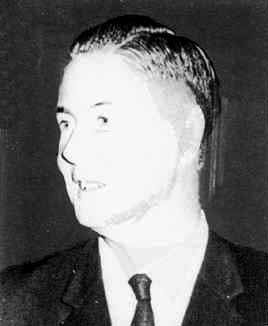

تاريخ الرياضيات

الاعداد و نظريتها

تاريخ التحليل

تار يخ الجبر

الهندسة و التبلوجي


الرياضيات في الحضارات المختلفة

العربية

اليونانية

البابلية

الصينية

المايا

المصرية

الهندية


الرياضيات المتقطعة

المنطق

اسس الرياضيات

فلسفة الرياضيات

مواضيع عامة في المنطق


الجبر

الجبر الخطي

الجبر المجرد

الجبر البولياني

مواضيع عامة في الجبر

الضبابية

نظرية المجموعات

نظرية الزمر

نظرية الحلقات والحقول

نظرية الاعداد

نظرية الفئات

حساب المتجهات

المتتاليات-المتسلسلات

المصفوفات و نظريتها

المثلثات


الهندسة

الهندسة المستوية

الهندسة غير المستوية

مواضيع عامة في الهندسة

التفاضل و التكامل


المعادلات التفاضلية و التكاملية

معادلات تفاضلية

معادلات تكاملية

مواضيع عامة في المعادلات


التحليل

التحليل العددي

التحليل العقدي

التحليل الدالي

مواضيع عامة في التحليل

التحليل الحقيقي

التبلوجيا

نظرية الالعاب

الاحتمالات و الاحصاء

نظرية التحكم

بحوث العمليات

نظرية الكم

الشفرات

الرياضيات التطبيقية

نظريات ومبرهنات


علماء الرياضيات

500AD

500-1499

1000to1499

1500to1599

1600to1649

1650to1699

1700to1749

1750to1779

1780to1799

1800to1819

1820to1829

1830to1839

1840to1849

1850to1859

1860to1864

1865to1869

1870to1874

1875to1879

1880to1884

1885to1889

1890to1894

1895to1899

1900to1904

1905to1909

1910to1914

1915to1919

1920to1924

1925to1929

1930to1939

1940to the present

علماء الرياضيات

الرياضيات في العلوم الاخرى

بحوث و اطاريح جامعية

هل تعلم

طرائق التدريس

الرياضيات العامة

نظرية البيان
Johannes de Groot
المؤلف:
D J Struik
المصدر:
P C Baayen, Biography in Dictionary of Scientific Biography
الجزء والصفحة:
...
3-12-2017
1464
Died: 11 September 1972 in Rotterdam, Netherlands

Johannes De Groot entered the University of Groningen in 1933 to study mathematics. Although mathematics was his main subject he also studied physics and philosophy as secondary subjects. After graduating, he went on to study for his doctorate which was awarded in 1942 for a thesis entitled Topological Studies.
Teaching at a secondary school was de Groot's first job. Then in 1946 he was appointed as a scientific officer at the Mathematical Centre in Amsterdam. There were two universities in Amsterdam, the University of Amsterdam (founded 1632) and the Free (Vrije) University (founded 1880). The Mathematical Centre, however, was an independent institution not attached to either of these universities.
The following year, de Groot was appointed a lecturer in mathematics at the University of Amsterdam. Then in 1948 he was appointed professor of mathematics at the Technological University of Delft. Four years later, in 1952, he was appointed Professor of Mathematics at the University of Amsterdam. He retained his position at the Mathematical Centre in Amsterdam and, in 1960, was appointed Head of Pure Mathematics there.
In 1964 he became Dean of the Faculty of Science at the University of Amsterdam and, at this time, he gave up his position of Head of Pure Mathematics at the Mathematical Centre but remained associated with the Mathematical Centre as Advisor to Pure Mathematics [3]:-
... actively participating in and in many instances decisively influencing its research activity.
De Groot worked in topology and group theory. In group theory one of the topics he studied was that of groups with only trivial automorphisms.
Later de Groot worked on set-theoretic topology. He introduced the concept of co-compactness and other topological concepts.
A recent book, J M Aarts and T Nishiura, Dimension and extensions (1993), has been published discussing a long-standing problem of de Groot. The main conjecture made by him has recently been solved. In a description of the contents of this book the problem of de Groot is described as follows:-
The problem of de Groot concerned compactifications of spaces by means of an adjunction of a set of minimal dimension. This minimal dimension was called the compactness deficiency of a space. Early success in 1942 lead de Groot to invent a generalization of the dimension function, called the compactness degree of a space, with the hope that this function would internally characterize the compactness deficiency which is a topological invariant of a space that is externally defined by means of compact extensions of a space. From this, the two extension problems were spawned.
De Groot received many honours, perhaps the most prestigious of which was his election in 1969 to the Royal Dutch Academy of Sciences.
- D J Struik, P C Baayen, Biography in Dictionary of Scientific Biography (New York 1970-1990).
http://www.encyclopedia.com/doc/1G2-2830905080.html
Articles:
- P C Baayen, The topological works of J de Groot, in Topological Structures - Proceedings of a Conference in honour of Johannes de Groot (1914-1972) (Amsterdam, 1974), 1-28.
- P C Baayen and M A Maurice, Johannes de Groot 1914-1972, General Topology and its Applications 3 (1973), 3-32.
 الاكثر قراءة في 1910to1914
الاكثر قراءة في 1910to1914
 اخر الاخبار
اخر الاخبار
اخبار العتبة العباسية المقدسة

الآخبار الصحية















 قسم الشؤون الفكرية يصدر كتاباً يوثق تاريخ السدانة في العتبة العباسية المقدسة
قسم الشؤون الفكرية يصدر كتاباً يوثق تاريخ السدانة في العتبة العباسية المقدسة "المهمة".. إصدار قصصي يوثّق القصص الفائزة في مسابقة فتوى الدفاع المقدسة للقصة القصيرة
"المهمة".. إصدار قصصي يوثّق القصص الفائزة في مسابقة فتوى الدفاع المقدسة للقصة القصيرة (نوافذ).. إصدار أدبي يوثق القصص الفائزة في مسابقة الإمام العسكري (عليه السلام)
(نوافذ).. إصدار أدبي يوثق القصص الفائزة في مسابقة الإمام العسكري (عليه السلام)


















